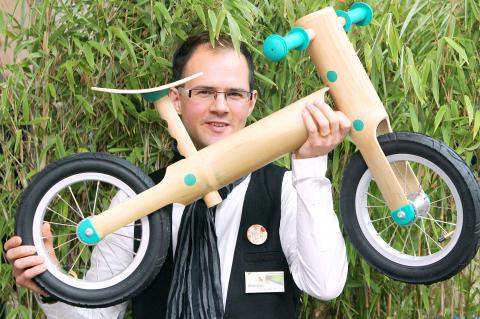The sight of tall, green bamboo stalks swaying above the dusty lands of his west African country led Ibrahim Djan Nyampong to an unusual conclusion: bicycles.
Under the shade at a workshop in Ghana, young artisans are making them — from mountain racers to cargo bamboo bikes — to suit needs of customers, now as far afield as the US and Europe.
“The beginning was not easy as people thought it was a joke to make bicycles from bamboo,” Nyampong said as he supervised work at the small factory outside Accra. “Now people are warming towards the bamboo bike.”

Photo: EPA
With bamboo a strong, affordable and environmentally friendly material readily available to manufacturers, African countries including Ghana, Uganda and Zambia have seen the start of production of such bicycles.
It hasn’t gone unnoticed. The Ghana initiative is one of 30 recipients of last year’s UN Environmental Programme SEED awards for projects that tackle poverty while promoting the sustainable use of resources.
US engineer Craig Calfee, among those credited with introducing the sturdy bicycles to Africa’s rugged terrain, said he developed the technique in 1995. It was not until 10 years later that he perfected the art and got his first bamboo bike on the market.
The idea of joining bamboo tubes with epoxy-soaked fiber crossed his mind when he was thinking of a “fun bike to draw publicity at a trade show.”
“While I am not the first to make a bicycle from bamboo, I am the inventor of the most effective method that most people are using now,” he said.
Bamboo grows quickly and has been popular with furniture crafters, among other industries, but it is now winning the hearts of environmentalists seeking sustainable building materials.
Bamboo bicycles can be designed to suit individual needs, including “school bus bikes” with multiple seats. Able to handle shocks and vibrations as well as heavy loads, the bikes have been seen as a potential solution for rural farmers — though the US$150 price for the labor-intensive product has limited sales locally.
“My friends have been using the bikes for a long time and they are still strong,” said 60-year-old farmer Kofi Kugbelenu, who traveled 320km from the Volta Region to place an order. “I’m buying one for myself and one for my son.”
After harvesting, stalks are smoked and heat-treated to prevent splitting. The tubes are then tacked with adhesive and wrapped using epoxy-impregnated fiber.
While frames are molded from bamboo, pedals, wheels and saddles are made of conventional materials. Nyampong said his organization was trying to develop its own bamboo bike handles and crash helmets.
Export demand has surged since the bikes were exhibited during US President Barack Obama’s visit to Ghana in 2009.
“Business is now booming, especially in the area of export,” Nyampong said.
He said his company expected to sell about 300 bikes this year, mostly for export to the US and Austria.
After six months on a tour of east and west Africa, Calfee came away with the impression that bamboo bikes would succeed.
“I remembered that there was a lot of bamboo, people valued bicycles and there was a great need for jobs,” he said.
The price puts the bicycles beyond the reach of many rural farmers in Ghana, where about a third of the population lives below the poverty threshold.
However, Nyampong, who has been making the bicycles since 2007, believes that with time the price will come down and demand for bamboo bikes will spike.

The Burmese junta has said that detained former leader Aung San Suu Kyi is “in good health,” a day after her son said he has received little information about the 80-year-old’s condition and fears she could die without him knowing. In an interview in Tokyo earlier this week, Kim Aris said he had not heard from his mother in years and believes she is being held incommunicado in the capital, Naypyidaw. Aung San Suu Kyi, a Nobel Peace Prize laureate, was detained after a 2021 military coup that ousted her elected civilian government and sparked a civil war. She is serving a

China yesterday held a low-key memorial ceremony for the 1937 Nanjing Massacre, with Chinese President Xi Jinping (習近平) not attending, despite a diplomatic crisis between Beijing and Tokyo over Taiwan. Beijing has raged at Tokyo since Japanese Prime Minister Sanae Takaichi last month said that a hypothetical Chinese attack on Taiwan could trigger a military response from Japan. China and Japan have long sparred over their painful history. China consistently reminds its people of the 1937 Nanjing Massacre, in which it says Japanese troops killed 300,000 people in what was then its capital. A post-World War II Allied tribunal put the death toll

‘NO AMNESTY’: Tens of thousands of people joined the rally against a bill that would slash the former president’s prison term; President Lula has said he would veto the bill Tens of thousands of Brazilians on Sunday demonstrated against a bill that advanced in Congress this week that would reduce the time former president Jair Bolsonaro spends behind bars following his sentence of more than 27 years for attempting a coup. Protests took place in the capital, Brasilia, and in other major cities across the nation, including Sao Paulo, Florianopolis, Salvador and Recife. On Copacabana’s boardwalk in Rio de Janeiro, crowds composed of left-wing voters chanted “No amnesty” and “Out with Hugo Motta,” a reference to the speaker of the lower house, which approved the bill on Wednesday last week. It is

FALLEN: The nine soldiers who were killed while carrying out combat and engineering tasks in Russia were given the title of Hero of the Democratic People’s Republic of Korea North Korean leader Kim Jong-un attended a welcoming ceremony for an army engineering unit that had returned home after carrying out duties in Russia, North Korean state media KCNA reported on Saturday. In a speech carried by KCNA, Kim praised officers and soldiers of the 528th Regiment of Engineers of the Korean People’s Army (KPA) for “heroic” conduct and “mass heroism” in fulfilling orders issued by the ruling Workers’ Party of Korea during a 120-day overseas deployment. Video footage released by North Korea showed uniformed soldiers disembarking from an aircraft, Kim hugging a soldier seated in a wheelchair, and soldiers and officials